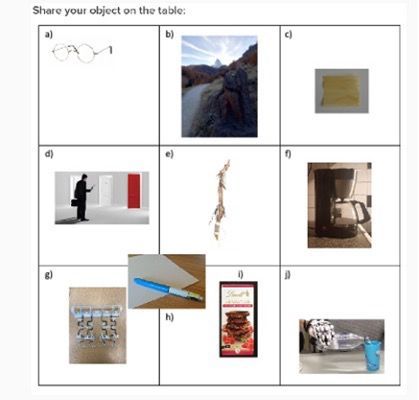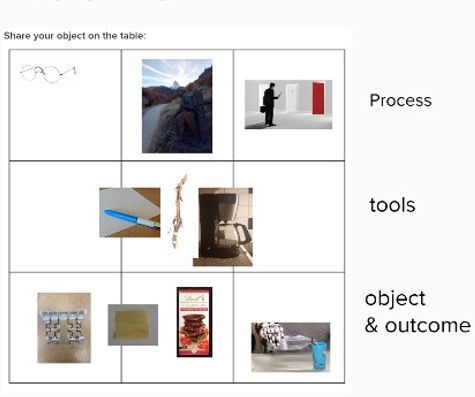Tell your story by means of an object – an online experience
‘Tell your story by means of an object’ was applied in an online seminar on transdisciplinarity, to learn more about how each participant experiences and practices transdisciplinarity.
Context
This experience report documents a one-hour activity that took place during a seminar which was part of the course ‘Transdisciplinary Research: challenges of interdisciplinarity and stakeholder engagement 701-0015-00L’ conducted by the Transdisciplinary Lab at ETH Zurich. During the fall semester in 2020, 17 participants enrolled and due to COVID-19 restrictions, the seminar had to be conducted online. Students were participants but also responsible to lead some of the sessions and especially to test some tools from the td-net toolbox.
Purpose
The goal of implementing ‘Tell your story by means of an object’ method in the context of these transdisciplinary seminars was to capture the diversity of perspectives that each participant has on ‘practicing transdisciplinary research’. It is important to note that none of the participants knew each other nor came from a similar disciplinary background. Hence, the purpose of this method was to allow participants to talk more about their experience, via the presentation of a symbolic object. The goal of the method is three-fold: (1) to allow each participant to make their implicit personal references, values, and emotions visible to the group, (2) to discover shared interests, common starting points and possible conflict potentials early on, and (3) to understand very personal approaches of the others.
Procedure employed
A week before the seminar, we sent an email to each participant explaining their homework:
- Reflection exercise: Take some time alone to think about your past experiences with TD, how you collaborated with various stakeholders, the challenges and outcomes of such experiences…
- Choose an object: If you had to choose one object to symbolize practicing transdisciplinary research, what would it be? Please choose something that can explain your personal relationship to practicing transdisciplinary research.
- Send a picture of your object: As the seminar was conducted online, we had to ask participants to send us a picture of their object before the day of the seminar.
- Sign in on the free online tool MURAL: the online tool ‘Mural’ is a digital workspace for visual collaboration.
On the day of the seminar, we introduced the guiding question “If you had to choose one object to symbolize practicing transdisciplinary research, what would it be?” and we shared with the participants a link to the online tool ‘Mural’. We, as moderators, had previously inserted the objects of all the participants in Mural next to a grid that we would use as a ‘virtual table’ to put the objects on. We asked each participant to take approximately 3 minutes to explain their relationship to transdisciplinary research and why they had chosen this specific object. Then, they had to place their object on the grid where they felt like it. We also were assuring that nobody was forced to share their story and that this exchange took place in a safe space where there was no right or wrong answer.
The following screenshot shows the 10 objects brought and described by the participants: (a) a pair of glasses, (b) a hiker, (c) construction material, (d) multiple doors, (e) a talking stick, (f) a coffee machine, (g) a Volkswagen car seat, (h) a pen and paper, (i) chocolate, and at last (j) a special cup used by physically disabled people.

After sharing their personal stories for approximately 30 minutes, we asked the participants to take 3 minutes for themselves to reflect on the objects put on the table and to think about patterns/similarities in what had been described. Where would they move the objects? How would they cluster them? Which words would be associated with the patterns observed? We then facilitated this procedure by asking further questions and moving the objects on the ‘virtual table’ on the mural link. The second screenshot (below) shows the final arrangement of the objects, that were categorized in terms of process, tools, and object/outcome. This categorization should not be understood as a way of hierarchizing the objects, but rather an attempt to cluster them. As the participants were satisfied with this re-arrangement of the objects, we quite quickly arrived to an agreement and were able to close the discussion on practicing transdisciplinarity and which skills were considered as important by the participants (e.g. communication skills, deep listening, reflection, team player skills…).

Findings
The conversation during this 50-minute exercise was centered around the complexity of collaboration, the need to acknowledge the partiality of ones’ experience or disciplinary biases, and the importance to listen to the others. People used many physical representations (objects) of the result of transdisciplinary collaboration such as the Volkswagen seat, the cup, or the chocolate. The stories behind these objects exemplified many relational issues and the need for the integration of perspectives:
- The participant who chose the armature seat found it representative of complexity. Indeed, even if it looks like quite a simple object at a first glance, in reality, its construction requires cooperation and skills from all around the world.
- The participant who chose the blue cup similarly wanted to represent the different expertise required to fabricate a cup engineered to be used by patients with an exoskeleton hand. Depending on the expertise, the blue cup will be perceived with nuances. Whereas the engineers need to quantify how much strength the exoskeleton hand needs to grab and lift a bottle to pour water in the cup, the occupational therapist rather needs to understand the abilities of the patient to ensure the capacity to poor the water in the cup without spilling. This example shows the different and complementary approaches that must come together to deliver a service for the end user.
- Finally, the example of the chocolate with berries illustrates that whereas it is easy to collect all the ingredients, the real challenge is to assemble them in order to prepare chocolate. In addition, the participant also explained that if a person was asked to describe the taste of this chocolate, it is likely that they would find it difficult to identify all the ingredients. For the participant, transdisciplinary research similarly to chocolate requires that much expertise and many disciplines come together and merge in order to create new knowledge.
During the discussions, we tried to find out what exactly the participants found essential in transdisciplinary research and what experiences they already had in practice. The idea behind this method is to learn more about each other’s personality via the process of the exercise and the object facilitates the process of sharing one’s story.
Lessons learnt
- We were surprised to discover the broad variety of pictures sent by the participants and this diversity created curiosity within the group that was eager to hear about each other’s story. The listening quality within the group was very good.
- The use of the mural online digital workplace worked well in general, even though some participants had some technical challenges to use it. We recommend to show how to write and move objects in the tool at the beginning of the exercise. In a digitalizing world, we think such tools are good to practice and can enhance online collaboration.
- The challenge for us, as moderators, was to choose the ‘guiding question’ as this precise group did not work together in a project but was only jointly enrolled in a seminar. Therefore, we could not ask a more precise question. We also wonder if the process of ‘moving the objects’ and ‘seeing patterns’ would have taken more time and created more debate or conflictual views if the participants were talking about something more precise than ‘practicing transdisciplinary research’.
- Participants found it easier to express their true beliefs as it was mediated by an object.
- We only had one hour for the exercise, which was the last activity of that seminar day. The 30 minutes planned for the 10 object presentations were perfect, we did not feel time was lacking or that it was too long. However, 20 minutes for the discussion about patterns might not be enough. If we had had more time, the object placement might have evolved more, and more debates might have arisen. We would suggest choosing a moment with less time restrictions for this exercise. We would also be curious about coming back to the discussion maybe a few weeks later to see if participants views have evolved or if new ideas emerged.

